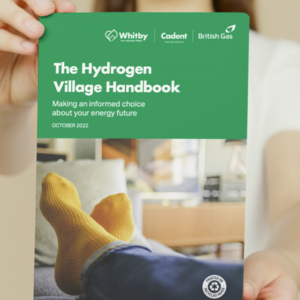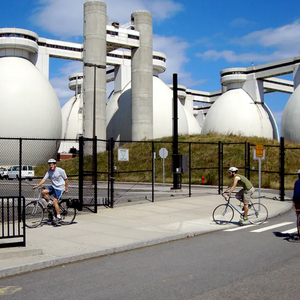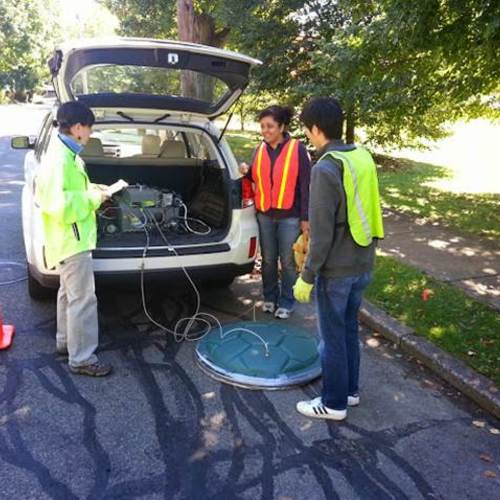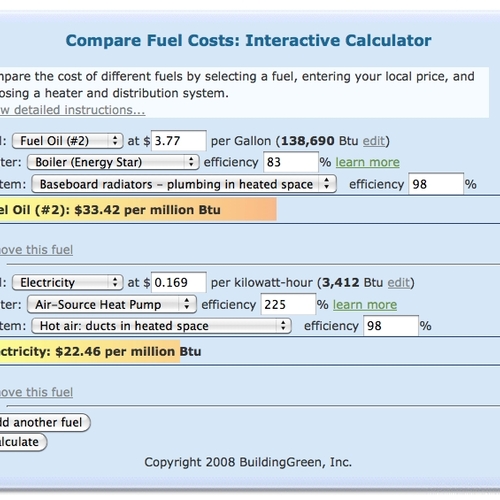
Most green builders want to choose an environmentally responsible heating fuel, which is why an increasing number of green homes are all-electric. To prevent catastrophic climate change, we need to make a rapid transition away from the burning of fossil fuels (including natural gas, propane, and oil) toward the use of renewable energy (for example, electricity generated by photovoltaic arrays or wind turbines).
That said, many builders and homeowners have been using natural gas for heating for many years. Before they make the switch to electricity, they often ask an important question: Which heating fuel is cheaper, natural gas or electricity?
In most U.S. states, the answer is natural gas — but there are exceptions. As with most energy-related questions, the accurate answer is, “It depends.”
Fuel prices vary
Natural gas is cheap in Alaska, where residential customers pay only $4.68 per 1,000 cubic feet. On the other hand, natural gas is expensive in Florida, where residential customers pay $16.77 per 1,000 cubic feet.
Electricity is cheap in Louisiana and Washington, where residential customers pay only 9.7 cents per kWh. On the other hand, electricity is expensive in Connecticut, where residential customers pay 20.3 cents per kWh — more than twice as much as homeowners in Louisiana.
When it comes to energy costs, Hawaii is an outlier. All forms of energy are expensive in Hawaii: natural gas costs residential customers $25.83 per 1,000 cubic feet, while residential electricity costs 29.5 cents per kWh. Fortunately, most Hawaiian residents don’t have to worry about heating fuel costs.
You have to do the math
If you want to know which heating fuel is cheaper in your area, you have to do the math.
Step one: Determine your local fuel prices. You can either look up these prices on your utility bills, call up your local utility, or use the statewide averages shown…
Weekly Newsletter
Get building science and energy efficiency advice, plus special offers, in your inbox.

This article is only available to GBA Prime Members
Sign up for a free trial and get instant access to this article as well as GBA’s complete library of premium articles and construction details.
Start Free TrialAlready a member? Log in















19 Comments
One of the most practical articles I've read here as that website consolidates all the energy source costing into one, easy chart.
For those interested in DUCTED minisplits on that website, what would be some general guidelines for the following?
Clicking the "See Details" box yields
-BTU’s per unit
-System efficiency
-Distribution efficiency
They have a ductless option, but nothing for ducted. I'm guessing it's the following:
Ducted Minisplit
-BTU’s per unit = 3412
-System efficiency = 200
-Distribution efficiency = 70
Would one typically use a lower COP for ducted and I read that site as a COP of 2.93 = System efficiency of 293.
With this article in mind ( https://www.greenbuildingadvisor.com/article/ductless-minisplits-may-not-be-as-efficient-as-we-thought ), I think a COP of 2 for ducted is on the high end but feasible. Are the distribution systems for ducted minisplits assigned the same efficiency as regular, forced air systems typically in calculations?
Also, I presume a propane furnace would be the following (just modify the natural gas furnace numbers):
Propane Furnace
-BTU’s per unit = 91501
-System efficiency = 90 to 95
-Distribution efficiency = 70
Whatever cost you get propane at would also need to be entered (obviously).
Thoughts of the crowd?
Fujitsu ducted does better than that.
Thanks for that. Source of those numbers? After the previously linked article ( https://www.greenbuildingadvisor.com/article/ductless-minisplits-may-not-be-as-efficient-as-we-thought ) I've always adjusted the COP of minisplits down a touch in my calcs for a "real world" reflection that I'd expect.
Those numbers come from an air source heat pump specification list that NEEP maintains. You can download the latest version from their website here: https://neep.org/initiatives/high-efficiency-products/emerging-technologies/ashp/cold-climate-air-source-heat-pump
You can also find the details in a lot of the manufacturer specifications, but that requires a lot more digging and I've never seen them be different than what NEEP collects. They also have COP ratings for 17* & 5*, which are interesting to look at when considering some of the extremes. You'll also see that the COP varies by whether the unit is operating at min or max capacity because the ability of a unit to modulate down to a low output varies by model and they often end up running less efficiently when they're in that in between place of needing to provide only a small amount of heating or cooling to the house.
Very timely, well done Martin !! The outlier here is electrical off peak rates and thermal storage. The utilities in the Midwest at least are investing in a lot of clean wind energy, where to go with the excess? Off peak storage of some type looks to be viable in terms of cost per million Btu's. We can compare the cost of natural gas but this is not available in many areas, so the equation is between electricity, propane and heating oil for many.
The discussion then focuses on energy upgrades and return on investment given the various heating fuels available. Fun stuff !! Time to act.
Doug,
Off-peak storage only works in areas with time-of-day metering. That's far from universal so far. Once we have time-of-day metering, everyone with onsite generation can have onsite storage and apps to help us optimize our energy use. Now that'll be fun stuff!
Add caveat #6. You can't make your own natural gas.
I made this spreadsheet last week for the same comparison. I made the heat pump COP and gas EF user selectable.
In my 4C climate, I was more optimistic on the COP (Fujitsu must not fail me.)
On the sheet, select row 3, select Data>Filter to make everything sortable.
This is a great article.
I had a home with only one gas appliance the furnace. I found it very painful to pay the gas bill in the spring, summer and fall months. The bills would show little or no usage but I would still pay about $25.00 a month. So there could be close to $300.00 a year in saving in connection fees, if you can just say no to a gas connection.
In my case the state average electric rate is not very helpful in this calculation. My summer rate is .1261 close to your average .136 for Missouri but my winter rate is much lower at .0724 rate. My guess is winter rates are not well reflected in your rate chart, and electric heat is cheaper in many more locations than your chart would indicate.
Walta
To compute the real cost of various heating options, the cost of the system, yearly maintenance and occasional repairs & replacements need to be considered. That furnace and distribution system (not to mention gas line or oil tank, chimney, ....) costs much more than your yearly cost to heat the home. So to be fair, the total cost of ownership needs to be considered. The installation and maintenance costs of a couple tens of thousands divided by a few decades of usage might rival the cost of the natural gas or oil fuel itself. The nice thing about that "expensive" electric heat is that it only costs a few thousand for a minisplit that provides both winter heat and summer AC! Or even cheaper room-by-room resistance heaters or radiant electric panels cost almost nothing compared to that fossil fueled furnace and distribution system. So the real cost of using electric heating is much cheaper than in the fuel cost tables suggest. (Not to mention the increased climate change impact of all that equipment and infrastructure that's needed to deliver that fossil fuel.)
Those of us who believe in high performance homes would use much more insulation, better air sealing, heat recovery ventilators, and better quality windows and doors. Those features and their additional initial costs would bring the heating and cooling load so low that few places in the USA would need to install a central heating and heat distribution system (which would help pay for those building shell upgrades). That's what drives an all-electric home. You can't cost-justify the central heating system anymore. Electric heating (mini splits, resistance and radiant heating units) no longer results in outrageously high electric bills, and cost little to install compared to those costly, complicated central heating systems.
Robert,
You have it exactly right, building a new home with very low energy needs is money well spent. So many space conditioning options become available and affordable with energy efficient homes. I used electric resistant baseboard in 4 superinsulated homes (R-50 wall R-70 ceiling) in the 80's and the owners liked the ability to control individual room temperatures. For AC we installed an in wall unit located in the 2nd floor hallway and this worked fine. AC was seldom needed but the single location unit would cool the whole house nicely.
Electricity at the time was 4.7 cents per kWh and the utility (NSP) was offering an off peak rate for electric thermal storage units. We did not install any of the units but they are still available today as an off-peak incentive for using electric heat.
In my mind the new frontier is residential energy retrofits for housing off the natural gas grid. The new cold climate heat pumps are very exciting and coupled with comprehensive weatherization older homes can become quite affordable to heat.
$3.50 propane and $3.00 heating oil is too brutal to contemplate in an older, inefficient home. Local community banks and utilities need to consider programs to help upgrade the existing housing stock so people can live in comfort and with piece of mind.
Nicely compiled information in this piece, especially with regard to fuel cost.
I would only take exception with point #5: “If you are a green builder, you may not care whether natural gas is a cheaper heating fuel than electricity, since natural gas pipeline leaks are a powerful driver of global climate change.”
Per ISO New England data, in the North East during winter, half of the grid’s electricity comes from gas power plants running at 33% efficiency and ¼ from nuclear. The reminder ¼ comes from hydro, coal, and “renewables” (mostly wood burning, trash incinerators and a little from the wind when it blows). PV generation is marginal on most cold winter days.
So as a whole, an 80% + efficient gas heater falls within the range of the best heat pump when it comes to emissions, and it’s certainly much better than resistance heating.
As pointed by Robert’s comment and often on this site, improved insulation and air sealing matter more than heating method. But as shown by the EPA study linked below, what matters even more in terms of energy usage and cost is location and housing type. I wish that this (very good) website dedicated a little more coverage to that topic.
https://www.epa.gov/sites/production/files/2014-03/documents/location_efficiency_btu.pdf
Vivian,
Good points.
Concerning CO2 emissions associated with grid electricity: You're right, of course. Every state is different, but in general, the grid is slowly becoming cleaner. In 5 or 10 years, CO2 emissions associated with the generation of electricity will be lower than they are today -- and to the extent that GBA readers install PV, we can all nudge the grid slightly in the right direction.
Concerning the fact that the location of one's home affects energy used for transportation, you're also right. Here are links to a few GBA articles on the topic:
"Location Efficiency"
"Where You Build May Matter More Than What You Build"
"Location Efficiency Trumps Home Energy Efficiency"
If we need to convert our entire economy to renewable energy within a few years, I'm not understanding the advantage of installing gas now at any price.
Bob,
I agree. GBA advises builders of new homes to go the all-electric route.
Thank you for another great article!
We have a good technical spreadsheet that you can adjust to local energy costs and modify efficiencies for most system types. We posted it on our website here for anyone to try out. https://performancebuildingsupply.com/cost-comparison-of-heating-sources/
Good article as always. Floating possibility of another caveat on comparing ductless heat pumps to ducted furnaces. I can understand why we didn't go there, it's enough for a separate article.
Using the rate table and efficiency Maine's heating cost calculator, I get much different results comparing ductless heat pumps to NG furnace with 70% distribution. Only 11 states appear to have gas cheaper than electricity using 82% NG Furnace and 250% ductless heat pump. Throwing out the wacky utility markets of AK and CA, the 9 states with lower gas than electricity heating costs had only a 6.7% average advantage in fuel costs. Seems like electricity is cheaper to heat with than gas for majority of country that doesn't live in heating-only climate.
Ductless NG heaters exist and might be a fair choice for climates with no AC needs. Most of the country however, relies on AC so doubling mechanical systems rarely makes sense economically.
For majority of population including those not in cold climates, a 2.5 seasonal COP is probably below average for ductless heat pumps.
Ductless heat pumps tend to be the most efficient option for AC, so year-round efficiency is improved compared to other appliance options. I'm not saying ductless is right for all projects but they can make a lot of sense when comparing to ducted gas furnaces.
To put some numbers on the monthly gas fee caveat, according to American Gas Association, the average cost in 2015 of monthly, minimum gas fees was $11.25 but actual cost to utilities is closer to $24 and trending upward. Using the average minimum fee, a home hooking up to NG just for heating, could add $2700 assuming a 20 year appliance lifespan with no inflation. That's a lot of money for zero gas usage.
https://www.aga.org/sites/default/files/ea_2015-03_customercharge2015_0.pdf
Tougher to put numbers on new construction infrastructure. Venting is extra, and our contractor charges a per appliance drop fee for indoor piping. Sometimes the gas company handles the line from the street but it's typically towards the end of the project with plenty of messy rework with the deep trench through mostly finished grading and erosion control. If utility is not handling the trenching and backfill, open up wallet.
One of my biggest concerns is the impossible cost of increased health-safety risk. With clients insisting on big vent hoods, more cases of malfunctioning MUA units, and "sealed" combustion appliances not working during vent hood operation despite proper MUA provisions, one has to question the wisdom of including ANY combustion appliances indoors. Indoor combustion sometimes adds functional inconvenience and always adds risk compared to all-electric.
Does anyone have data on when you add solar to heat pumps vs gas? I've heard a guy mention when he net metered solar and air source heat pumps it was less expensive than gas...
Davin,
I assume that when you mention "solar" you are talking about a photovoltaic (PV) system, not a solar thermal (hot water) system. Whether or not an investment if a PV system will lower your energy costs depends on a great many factors, including the following:
1. The cost to install your PV system.
2. The details of the net-metering contract offered by your local electric utility.
3. Whether or not the PV system is eligible for any rebates or tax credits. (These rebates and tax credits vary from state to state.)
4. The cost of electricity in your area.
5. Whether or not you can afford to pay for the PV installation with cash, or whether you have to borrow the money from a bank.
The bottom line: if the cost to install your PV system is reasonable, and you live in a state with favorable net metering contracts, and you can afford to pay for the installation, a PV system may be among the best investments you can make, with the return on your investment beating returns on the stock market or bond market. In Massachusetts, for example, many homeowners who installed PV enjoyed enough energy savings to pay off the cost of their PV installation in just 5 or 6 years, after which their electricity will be close to free.
On the other hand, some utilities offer net metering agreements that are unfriendly to PV -- in some cases charging a high rate for homeowners' electricity purchases, while offering a much lower rate for homeowners' electricity generation. If your local utility is unfriendly to PV, and your PV system is expensive to install, the payback period for a PV installation might be 25 or 30 years.
Log in or become a member to post a comment.
Sign up Log in